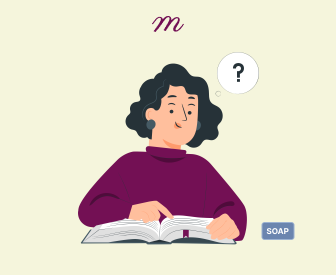Have your progress notes written for you automatically
The mental status examination (MSE) is a crucial tool used by mental health professionals to assess a patient’s current psychological state. It’s a structured evaluation that goes beyond just symptoms and delves into the patient’s overall behavioral and cognitive functioning. The MSE also aids psychotherapists, social workers, and psychiatrists in finding an accurate diagnosis, monitoring treatment progress or lack thereof, and informing treatment plan recommendations and therapeutic interventions.
This blog post will explore…
- The 5 critical components of the mental status exam
- Clarification around ‘affect’ and other terms commonly used but frequently misunderstood in the mental status exam.
- The 4 P’s of Mental Health Assessment.
- Tips and tricks for conducting the mental status exam.
Let’s jump in!
The 5 Key Components of the Mental Status Exam
1. Appearance and Behavior. Presentation of appearance and behavior commonly refers to how an individual appears at the onset of the session. Therapist observation is made of an individual’s physical appearance, grooming, and overall behavior. Look for unusual or inappropriate behaviors, such as restlessness, agitation, or bizarre clothing choices. Two examples include a client who shows up to a session in mid-July wearing a winter parka or another who is odorous, has patches of hair missing, and is unkempt.
Appearance and behavior also include the individual’s demeanor, any notable mannerisms, or other behavior such as restlessness, fidgeting, eye contact, body language, and overall level of engagement. An individual’s speech should also be assessed, including looking at rate, volume, fluency, and content in demonstrated speech patterns,
A clinician must consider how a client’s cultural background affects their appearance and behavior and not place value judgments based on their own life experience. An example is an Indigenous client may feel emotionally unsafe during an assessment with a white clinician. The white clinician may identify the client as ‘guarded’ or ‘uncooperative,’ but the reality is the client is rightfully bringing their survival skills from a historical context into the interaction.
2. Thought Processes. This includes assessing the individual’s thinking patterns and how thoughts are organized. Observe for signs of coherence, logic, and reasoning, the ability to convey an organized timeline and stay with one line of thinking, and whether or not the client’s speech makes sense. If a client is difficult to follow in conversation, a therapist would categorize their speech patterns as tangential or circumstantial, which may be indicative of a thought disorder. Word salad is an extreme type of disorganized thought pattern and exists when an individual says a string of words, each having nothing to do with the next. A therapist should note any signs of disorganized thinking, tangentiality, or racing thoughts.
‘Do you ever see things that other people don’t see?’
‘Do you ever hear things that other people don’t hear?’
Sometimes, a client may respond ‘no’ to these questions but then appears to be laughing out of nowhere, talking to someone who is not there, or trying to grab something in the air you cannot see. In this case, a therapist documents, ‘Client denied experiencing auditory and visual hallucinations but appeared to be responding to internal stimuli.’
‘Do you ever feel suspicious of other people?’
‘I’ve noticed you looking at the corners of my ceiling. May I ask what you are looking for?’
4. Cognition. This portion of the MSE assesses the individual’s cognitive functioning, including their awareness of space, time, person, and place, as well as memory, attention, and executive functioning. When a therapist assesses memory, they begin the cognitive assessment by telling the client five random words, such as car, rabbit, hotel, planet, and sand. They then let the client know they will ask the client to repeat those words in a few moments. The therapist then asks common questions used to assess cognitive functioning, including, ‘What is your name?’ ‘What is the date?’ ‘If you were walking down the street and found an envelope with an address and stamp, what would you do with it?’ ‘and ‘Who is the President of the U.S. right now?’ Following these questions being answered, the therapist asks the client to repeat the five words said a few minutes prior.
5. Mood and Affect. This evaluates the individual’s emotional state and the expression of feelings they are experiencing. Therapists assess a client’s overall mood, how their face and body language demonstrate their feeling state, and the appropriateness of emotional responses.
Assessing affect is not always straightforward; documentation around this aspect of a client’s presentation can be confusing.
Let’s dive deeper to clarify.
Let’s Talk About Affect!
Affect is a crucial component of the mental status exam and is also typically used at the start of every psychotherapy progress note. Assessing effect means observing the client’s emotional state and expression of the feelings they are experiencing.
The ABCs of Affect
To assess emotional states objectively, it can be helpful to remember the ABCs of Affect.
Affect: Affect refers to the individual’s current facial expression of their emotional state.
Behavior: Behavior refers to the individual’s observable actions, mannerisms, and movements that express their emotional state.
Cognition: Cognition involves the individual’s thoughts, beliefs, or perceptions associated with their emotions.
The 5 Descriptors of Affect
After assessing affect, objective clinical documentation on the presented feeling state is imperative to ensuring the client’s chart can provide an accurate, thorough snapshot of the client’s presentation and current level of symptoms for future reference. The mental status exam and the progress note both typically remark on client affect. This is often done using one of 5 descriptors followed by a comment on the client’s behavior observed and verbalized statements.
The 5 Descriptors of Affect are…
- Euthymic: Euthymic effect refers to a normal range of emotions. In other words, the client doesn’t appear to be bottling feelings up or being overly expressive. They may even appear tranquil or calm.
- Depressed or Tearful: Depressed mood and affect involve a pervasive feeling of sadness, hopelessness, or a lack of pleasure or interest in activities they previously found enjoyable. It is often associated with Major Depressive Disorder. Depressed affect and mood can include crying spells and tears but do not have to in order to be considered as such.
- Elevated: Elevated affect represents an abnormally heightened emotional state. It can look like extreme happiness, euphoria, irritability, or easy to anger. These conditions are frequently seen during manic or hypomanic episodes.
- Labile: Labile affect refers to emotional states that rapidly and unpredictably change during the course of an interaction. The individual may laugh euphorically one minute and then suddenly break out into sobs the next.
- Constricted, Blunted, or Flat: Constricted and blunted affect indicates a client is holding in emotions and is currently unable or unwilling to express them. Constricted affect might look like someone with tears in their eyes, whereas blunted affect looks like someone with difficulty smiling, even if they typically find something funny or enjoyable. In the case of flat affect, this is often associated with looking and feeling numb.
Examples of Documenting Affect
Example 1: The client is a 42-year-old Mexican American unpartnered woman who identified as a lesbian and is seeking treatment following her mother’s death. During the assessment, the client was cooperative with questioning and demonstrated euthymic mood and congruent affect. The client teared up at times when describing her mother’s recent passing and exhibited a normal range of emotions associated with the grief process.
Example 2: The client is a 21-year-old biracial Caucasian/Black American male presenting to therapy following a psychiatric hospitalization. The client presented with labile affect, including tearfulness, laughing hysterically following a joke he told, and anger at the clinician within a 10-minute span. The client demonstrated a tangential thought process, pressured speech, and was hyperverbal throughout the assessment.
The 4 P’s of Mental Health Assessment
Another helpful framework to use when evaluating the various aspects of an individual’s presentation and mental health is the 4 P’s of mental health assessment. These are also used in the Biopsychosocial Assessment.
Predisposing Factors – These are factors in a client’s life that contribute to the presenting problem. They can include genetic, biological, or environmental influences and past childhood experiences.
Precipitating Factors – This refers to events or experiences that have contributed to or led to the client’s presenting problem. This can include trauma, environmental or relationship stressors, or a recent loss of a loved one or job.
Perpetuating Factors – These are ongoing stressors in the client’s life, such as addiction, an abusive or strained marriage, or caretaking for a loved one who is medically fragile.
Protective Factors – This looks at the positive aspects of a person’s life as a part of case conceptualization. Protective factors include strengths, community and social supports, hobbies, healthy coping skills, and a history of success at school or work.
Tips and Tricks for Conducting a Mental Status Exam
Each clinician must conduct an MSE in a way that is comfortable for them and provides accurate results. Here are some general guidelines for conducting a comprehensive mental status exam.
- Rapport Building is Key. Begin by introducing yourself and explaining the purpose of the assessment. Be keen to create a safe, non-judgmental environment to help the individual feel comfortable answering questions honestly.
- Gather Information Throughout the Session. Start by asking open-ended questions to gather background and demographic Information. This is also an excellent time to ask about the precipitating event or chief complaint that brought the client to your office and any current stressors or recent significant life events that may be affecting them. Then, over time and as a client’s comfort level grows, you can ask more directed questions to assess specific components of the MSE, such as regarding memory and cognition.
- Observe Appearance and Behavior. Pay attention to the individual’s physical appearance, grooming, and any noticeable behavior patterns. It is common for new therapists to initially feel some discomfort with this portion of the mental status exam as the therapist may worry they are judging the client. One way to reframe this is to know that when you document bizarre or otherwise ‘negative’ observations, you are recording the client’s baseline presentation, which will be a valuable portion of the client’s chart for future reference.
- Seek Support as a Therapist. If a therapist needs clarification on documenting a client’s behavior, appearance, affect, or thought process, seeking consultation from a more experienced clinician is wise. This helps ensure accuracy and objectivity.
- Use All Resources Available. Deep breathing and other coping skills to manage difficult emotions are vital internal resources a clinician can use during a session. Other resources include technology that makes documenting the mental status exam and other clinical documentation easier. For example, Mentalyc is a HIPAA-compliant psychotherapy notes software that uses AI to help psychotherapists complete MSE exam outcomes, assessments, and progress notes in a fraction of the time it would typically take and maintain a higher level of objectivity in their progress notes. Click here to watch a video describing how Mentalyc works.
- Summarize the Findings. After completing the examination, summarize any observations and related concerns. This summary will aid in finding an accurate diagnosis and treatment plan.
Conclusion
Conducting a comprehensive mental status exam is an essential skill for all mental health professionals. By assessing the various components of an individual’s presentation, including appearance, behavior, thought processes, perception, cognition, and affect, clinicians can gain valuable insights into an individual’s mental health struggles and subsequently provide them with more accurate diagnoses, formulate effective recommendations, and engage the client in more personalized treatment.
Sources:
- Voss RM, M Das J. Mental Status Examination. (Updated 2022 Sept. 12). In: StatPearls (Internet). Treasure Island (FL): StatPearls Publishing; 2023 Jan-. Available from: https://www.ncbi.nlm.nih.gov/books/NBK546682/










